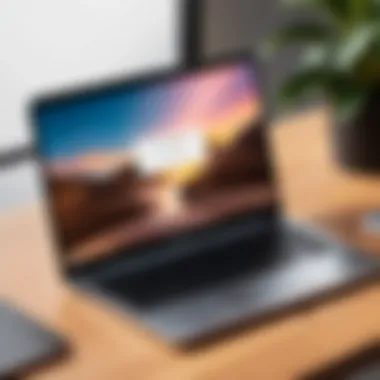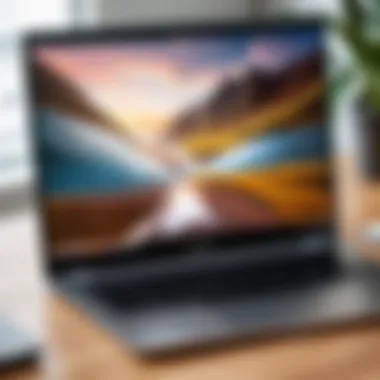Accessing Your Chromebook Remotely: Complete Guide


Intro
In today's interconnected world, being able to access your devices from different locations is becoming increasingly essential. The Chromebook, known for its simplicity and efficiency, can also be part of this trend. Remote access allows users to navigate their Chromebook from any internet-connected device. This guide explores various methods, tools, and best practices for accessing a Chromebook remotely, offering substantial depth and insight into the topic.
Overview of the Technology
Modern remote access technologies enable users to control their devices from afar. These tools capitalize on internet connectivity to establish a secure link between the remote device and the user's controlling device. Understanding the key specifications and unique selling points of these technologies will help users make informed choices.
Key specifications
- Compatibility: Most remote access tools can work across different operating systems, ensuring that users can connect to their Chromebooks from Windows, macOS, or even mobile devices.
- Security Features: Many tools provide encryption for data transmission, two-factor authentication, and the ability to limit access to specific users or devices.
- Performance: The speed and responsiveness of remote access tools can vary. High-performance options typically offer lower latency and higher quality video streaming.
Unique selling points
- User-friendly interfaces: Many remote access applications are designed with simplicity in mind, often providing intuitive navigation for users less familiar with technology.
- Multi-platform support: Users can seamlessly switch between devices and operating systems.
- Cost-effective solutions: Several remote access tools offer free tiers or affordable subscription models, making them accessible.
"Remote access technology empowers users, putting control at their fingertips, no matter the distance."
Design and Build Quality
Although this section may not traditionally relate to remote access, understanding the physical design of Chromebooks can influence ease of use during remote sessions.
Material used
Chromebooks are typically constructed with materials that are intended to be lightweight and durable. The plastic casing used in many models can endure daily wear while keeping the device portable. This is particularly helpful for users who frequently connect remotely.
Ergonomics and usability
An ergonomic design can enhance the user experience when accessing a Chromebook from a distance. Keyboards with comfortable spacing and responsive keys can make typing during remote sessions much more efficient. Additionally, screen resolution plays a vital role; higher resolutions provide clearer visuals, establishing a better experience when navigating remotely.
Understanding these aspects provides a solid foundation for the reader as they delve further into the specifics of accessing their Chromebooks remotely. Armed with knowledge of essential technologies and equipment, users can start exploring remote access setups in the following sections.
Intro to Remote Access
Remote access technology has become an essential aspect of computing, particularly for Chromebook users. This section presents an overview of remote access and its significance in today’s tech-driven world. With the ability to connect to a Chromebook from virtually anywhere, the advantages become clear. Flexibility, increased productivity, and enhanced collaboration are just a few benefits remote access offers.
Understanding the tools and methods available for remote access is vital for maximizing the utility of a Chromebook. As more individuals and organizations adopt remote work models, knowing how to access your device remotely can differentiate between staying productive and becoming bogged down.
Understanding Remote Access
Remote access allows users to connect to their devices from different locations. Users can operate their Chromebook as if they were in front of it, regardless of geographical barriers. This functionality is achieved through various software applications and tools that facilitate the connection process.
The technology operates by establishing a secure link between your current device and the desired Chromebook. It can provide access to files, applications, and even the entire desktop environment. Knowing how this process works is not just beneficial but essential for anyone who relies on their Chromebook, especially for work or academic purposes.
Importance of Remote Access for Chromebook Users
For Chromebook users, the ability to access their devices remotely is not only a convenience but a necessity in many cases. The reliance on cloud-based applications makes Chromebooks popular among users, but it also requires a reliable method to access data and tools when away from the device.
Key points of remote access for Chromebook users include:
- Increased Flexibility: Users can work from various locations without being tied to their physical device.
- Enhanced Collaboration: Team members can easily collaborate on projects without needing to be in the same room, which is crucial for remote work.
- Access to Applications: Not all applications are cloud-based. Remote access allows users to use applications that may only be installed on their Chromebook.
- Support and Maintenance: IT support can quickly assist or troubleshoot issues remotely, minimizing downtime.
Remote access is transforming how users interact with their devices, making it vital for efficient use of resources and time.
Prerequisites for Remote Access to Chromebooks
Remote access allows users to control their devices from anywhere, which is increasingly valuable in today's mobile-centric world. However, accessing a Chromebook remotely is not always straightforward. Understanding the prerequisites ensures a smooth remote experience. Without proper setup, frustrations may arise, and potential security risks could emerge. This section will discuss essential requirements necessary to effectively access a Chromebook remotely.
Required Software and Applications
To initiate remote access, specific software and applications are fundamental. The primary application for Chromebook users is Chrome Remote Desktop. This tool provides a simple interface and robust performance. It integrates seamlessly with the Chrome browser, making it accessible for users already familiar with the platform. Installation is straightforward and does not require extensive technical knowledge.


Other applications can also facilitate remote access. TeamViewer is a popular alternative. It offers additional features, like file transfer capability. Users looking for more advanced options might find these beneficial.
Here’s a brief overview of software options:
- Chrome Remote Desktop: Free, easy to set up, and ideal for basic needs.
- TeamViewer: Offers added features but may need a license for commercial use.
- AnyDesk: A similar platform with low latency and good performance.
Network and Connectivity Requirements
A stable network connection is crucial for smooth remote access. Both the host Chromebook and the device used for access need reliable internet access. The speed of the connection affects performance; high-speed internet is preferable. Wi-Fi connections can often be sufficient, but wired connections generally offer better reliability.
Specific considerations include:
- Bandwidth: Ensure that the internet can support the remote access software effectively. Higher bandwidth allows better video and audio streaming.
- Firewall Settings: Some networks may have firewalls that can block remote access software. Users must verify whether their firewall settings allow connections through Chrome Remote Desktop or any chosen application.
- VPN Considerations: If using a Virtual Private Network (VPN), ensure it does not impede remote access capabilities.
Understanding these prerequisites sets the stage for successful remote access. Taking the time to ensure both software and network requirements are met will lead to a more productive and secure remote experience.
"Having the right tools and a reliable internet connection is essential for accessing your Chromebook remotely."
Setting Up Remote Access on Your Chromebook
Setting up remote access on your Chromebook is a critical step for users needing flexibility and convenience in their computing tasks. This section delves into the methods available, focusing on their functionality and benefits. Understanding these methods allows users to maintain productivity regardless of location. Remote access opens doors to accessing files, applications, and settings securely from distant locations.
As working environments change, knowing how to configure and use remote access tools becomes essential. Many users find themselves traveling or working across various locations, making it necessary to connect to their devices seamlessly. Effective setup of these tools ensures you have a reliable experience and minimizes disruptions to workflow.
Using Chrome Remote Desktop
Installation Process
The installation process of Chrome Remote Desktop is quite straightforward. This application is integrated within the Google ecosystem, making it convenient for users who already rely on Google services. To start with the installation, users must visit the Chrome Web Store. There, they can find the Chrome Remote Desktop application, which is free to download and easy to set up.
One of the key characteristics of this installation process is its simplicity. Your Chromebook will guide you through the steps, allowing even those with minimal technical knowledge to install it effectively. After installation, users can access their devices on various platforms, making it a beneficial choice for remote access purposes.
However, like any application, it has its unique features. For instance, it supports multiple operating systems, enabling users to access their Chromebooks using Windows, macOS, or even mobile devices. On the downside, some users may experience connectivity issues if their internet connection is unstable.
Configuration Steps
Once installed, the configuration steps of Chrome Remote Desktop are intuitive. Users need to set up a remote access code and select which devices to enable for connection. This step ensures that only authorized users can access the device. The method is straightforward, providing a user-friendly interface that makes the configuration process almost seamless.
The unique feature of the configuration process lies in its ability to establish a unique access code for secured connection. This adds a layer of security to remote access, which is essential for protecting personal and professional information. While this method serves its purpose well, some users might find the need to remember these access codes inconvenient.
Alternatives to Chrome Remote Desktop
Third-Party Applications
For those who seek alternatives to Chrome Remote Desktop, several third-party applications offer robust features. Programs like TeamViewer and AnyDesk provide powerful solutions for accessing a Chromebook remotely. These applications emphasize collaboration, allowing multiple users to connect to one device for support or development purposes.
A significant characteristic of third-party applications is their advanced tools for file transfer and session recording. These features enhance user experience and functionality, making them favorable options for many. Additionally, they may support cross-platform connectivity better than some native applications. However, the trade-off may include subscription fees for full functionalities, which can deter some users.
Built-In Features in Other Operating Systems
The built-in features in other operating systems also present strong options for remote access. For example, Windows has its Remote Desktop feature, which allows users to access their PCs from remote locations. Such functionality is appealing for Chromebook users who also utilize Windows devices, as it can enhance productivity across systems.
The prominent characteristic of built-in features is their integration with the operating system, providing a native experience without the need to install additional software. This often results in faster performance and improved reliability. Nonetheless, the downside is that Chromebook users might require additional setup to connect with these features in a Windows environment, which could lead to a steeper learning curve for some.
Accessing Your Chromebook Remotely
Accessing a Chromebook remotely is increasingly essential in today's digital landscape. As more people embrace remote work and online learning, understanding how to connect to your device from a different location becomes crucial. Whether you need to access important files for a work project or participate in an educational session, remote access ensures you maintain productivity without being physically present.
The ability to access your Chromebook remotely brings several benefits, such as increased flexibility and efficiency. You can troubleshoot issues on your device without needing to be in front of it, which can be a lifesaver in critical situations. Furthermore, for users who work from multiple locations or who travel frequently, having remote access means you can easily retrieve files or run applications from anywhere with internet connectivity.
However, remote access also requires careful consideration. Users must understand the potential challenges, such as connectivity issues and security risks. It is vital to set up secure connections and be aware of who has access to your device remotely. Understanding these elements enhances not only your operational efficiency but also safeguards your data.


Establishing a Remote Connection
To establish a remote connection to your Chromebook, you first need to select an appropriate method that suits your needs. The most common approach is using Chrome Remote Desktop, which requires installation and configuration. To start, ensure you have a stable internet connection on both the host and remote devices.
Here are the general steps involved in establishing the connection:
- Install Chrome Remote Desktop: Download the extension from the Chrome Web Store and follow the instructions to set it up.
- Enable Remote Access: On your Chromebook, go to the Chrome Remote Desktop settings, and click on Enable Remote Connections. You will need to set a PIN for secure access.
- Remote Device Access: On your secondary device, access the Chrome Remote Desktop app or website, log in, and enter the gifted PIN to connect.
- Verify Connection: Ensure your devices are properly connected. You can now control your Chromebook remotely.
Each of these steps plays a crucial role in ensuring a smooth connection. Performance may vary based on your internet speed and the distance between devices.
Navigating the Chromebook Interface Remotely
Once you have established a remote connection, navigating your Chromebook interface becomes essential. Many users find the layout familiar, but this experience may slightly differ based on the remote platform being used.
Here are key points to consider when navigating:
- Mouse and Keyboard Controls: Remote platforms typically allow you to use your mouse and keyboard as if you were physically in front of the device. Familiarize yourself with any variations in control if using a third-party application.
- Managing Applications: You can use all applications, just as you normally would. Open apps through the taskbar or use the search feature. Performance might vary based on bandwidth, so patience is necessary if latency occurs.
- Adjusting Settings: While connected, you can modify system settings, manage files, and perform regular operations on your Chromebook. Think about using cloud storage for easy file access, as this makes it easier to manage documents regardless of your Chromebook's physical location.
"Establishing a solid remote connection provides not just access, but the potential for uninterrupted workflow, regardless of the working environment."
Overall, accessing your Chromebook remotely can greatly enhance your productivity and flexibility. By mastering both the connection process and the navigation of your device, you can fully utilize the benefits of remote access technology.
Security Considerations for Remote Access
Understanding security considerations in remote access is crucial for all Chromebook users. When you access your device from a different location, there are many factors to account for to safeguard your data. The main focus should be on maintaining the integrity, confidentiality, and availability of the data you access remotely.
Protecting Your Data
Protecting your data is a fundamental aspect of secure remote access. Users should employ strong, unique passwords for their accounts on Chromebooks. Avoid common passwords that are easy to guess, as they pose significant vulnerabilities. Enabling two-factor authentication (2FA) provides an additional layer of security. This method requires not only a password and username but also something that only the user has on them, such as a text message code or an authentication app code.
Utilizing a Virtual Private Network (VPN) adds another protective measure. A VPN encrypts your internet connection, shielding your data from potential interception. When using public Wi-Fi, a VPN is particularly relevant due to the inherent vulnerabilities of these networks.
Moreover, regularly updating your Chromebook's operating system and applications is vital. These updates often include security patches that protect your device from new vulnerabilities. Keep in mind that an outdated system can be exploited by malicious entities, compromising your data integrity.
Recognizing Potential Risks
When accessing your Chromebook remotely, it is essential to recognize potential risks involved. Phishing scams are one of the most common threats. Cybercriminals may impersonate legitimate services to deceive you into providing personal information. Always scrutinize emails or messages requesting sensitive information, especially those linking to external sites.
Additionally, unsecured networks expose your connection to risk. Using public Wi-Fi or any untrusted network increases chances of data breaches. If you must work on such networks, ensure your VPN is active.
Another element to consider is the software you use for remote access. Not all applications provide uniform security. Research and select applications that are known for robust security features. Check for encryption, data leak prevention, and a clear privacy policy.
Staying vigilant and aware of these risks plays a key role in ensuring your remote access experience remains secure and stress-free.
"In the digital age, security is not an option; it is a necessity."
By focusing on protecting your data and understanding potential risks, Chromebook users can effectively manage their security during remote access.
Troubleshooting Common Issues
Troubleshooting common issues is essential for anyone looking to access their Chromebook remotely. Technology is not infallible and encountering problems can be frustrating. Addressing these issues promptly ensures that users maintain productivity and secure their data effectively.
Connection Problems
Connection problems can arise for several reasons. The most common culprits include unstable internet connections, misconfigured settings, or issues with VPNs.
- Check Your Internet Connection:
A stable internet connection is crucial. Begin by ensuring that both your local device and the Chromebook are connected to reliable networks. You may also want to restart your router to see if that helps. - Validate Remote Desktop Settings:
Ensure that the Chrome Remote Desktop setup is functioning correctly. This involves checking that you have installed it properly and configured the settings according to the documentation. If necessary, revisit the setup steps outlined earlier in this article. - Firewall Conflicts:
Sometimes, a firewall on the local device or router may obstruct your remote connection. Check whether security settings or firewalls are preventing access. It may be necessary to configure them to allow traffic for remote access applications.
Important: Regularly updating your software can mitigate many connection issues. Always ensure your operating system and applications are current.
Application-Specific Issues


Application-specific issues may arise when dealing with remote access tools. Different applications have unique settings that can result in performance hits or accessibility problems.
- Compatibility Issues:
Confirm that the application is compatible with your Chromebook model and the operating system version you are using. Not all applications may provide full functionality across all devices. - Configuration Settings:
Every remote access application has its own settings for optimal performance. Overlooked configuration may result in slow performance or lack of functionality. Review these settings meticulously to ensure everything is correctly adjusted. - Application Updates:
Like your operating system, remote access applications should also be kept up to date. Failure to install updates can introduce bugs or compatibility issues. Regularly check for updates and install them when available.
By being proactive and addressing these common problems, you can enhance your remote access experience. Understanding the potential pitfalls can save time and prevent unnecessary frustration.
Practical Use Cases for Remote Access
Remote access is not merely a convenience; it has become a necessity in our increasingly digital world. With the rise of flexible work environments and remote learning, understanding practical applications of remote access for Chromebooks can greatly enhance productivity and effectiveness. This section will explore various scenarios where accessing a Chromebook remotely can prove advantageous. It will highlight the integral aspects and benefits, ensuring that readers have a well-rounded grasp of the topic.
Remote Work and Productivity
The landscape of work has evolved significantly in recent years, prompting a demand for efficient remote access solutions. Chromebook users can benefit from this by maintaining productivity levels, regardless of location. Having the ability to access work files, collaborate on projects, and participate in meetings all while away from the physical workstation is pivotal.
Key Benefits:
- Flexibility: Remote access grants users the freedom to work from various locations without interruptions.
- Collaboration: Many remote access applications, like Google Drive and Chrome Remote Desktop, facilitate real-time collaboration. This enables teams to work seamlessly despite geographical barriers.
- Resource Utilization: Employees can access powerful workplace applications on their Chromebook that are otherwise limited to office-based systems.
"In today's work environment, being able to work from anywhere fosters not just productivity, but also job satisfaction."
By utilizing remote access, professionals can ensure they do not miss critical deadlines or communications. They can stay connected to colleagues, access necessary software, and manage tasks effectively. This capability becomes even more important during times of unforeseen circumstances, such as a global pandemic, where remote work transforms from an option to an imperative.
Educational Applications
Educational institutions are also leveraging remote access technology to enhance learning outcomes. For students using Chromebooks, the ability to connect remotely opens a range of opportunities for collaboration and learning. This encompasses access to resources, participation in classes, and collaboration on projects.
Considerations:
- Access to Educational Resources: Students can remotely access course materials, e-books, and online platforms hosted on school servers.
- Virtual Classrooms: Many educational programs utilize platforms that allow live interaction with instructors and peers, supporting a more engaging learning experience.
- Group Projects: Remote access allows students to collaborate on projects in real-time, regardless of where they are located. They can share files, communicate, and make edits simultaneously.
The educational sector's adaptation to remote technology highlights its essential role. With tools like Google Classroom, educators can assign, assess, and provide feedback from anywhere. This not only aids in learning outcomes but also prepares students for a tech-driven future.
In summary, practical applications of remote access for Chromebooks underscore its importance in both professional and educational domains. By enabling seamless access, collaboration, and resource sharing, users are equipped to navigate the demands of modern work and study environments with greater ease.
Future of Remote Access Technology
The advancement of remote access technology holds significant relevance in the context of Chromebook use. As remote work and online learning become increasingly integral to our daily lives, understanding the future of remote access can help users maximize the capabilities of their Chromebooks. It is essential to explore not only the emerging trends but also how these innovations could transform user experiences.
Emerging Trends in Remote Access
Remote access is not static; it evolves rapidly with technological advances. Some prominent trends include:
- Cloud-based Solutions: Services such as Google Workspace and Microsoft 365 are enhancing remote connectivity through cloud computing. This allows users to access applications and files from any device, fostering seamless collaboration.
- AI and Automation: Artificial intelligence is gradually optimizing remote access tools, improving connection reliability and user experience. Automation can help simplify routine tasks that might otherwise hinder productivity.
- Enhanced Security Protocols: As remote access technology matures, the emphasis on security strengthens. Newer systems are implementing multi-factor authentication and end-to-end encryption to protect sensitive data.
These trends indicate a shift toward more flexible, efficient, and secure remote access solutions.
Potential Impact on Chromebook Development
The progression of remote access technology may also influence the future development of Chromebooks. The following points highlight important considerations:
- Increased Hardware Capabilities: Enhanced remote access features may require more robust hardware, prompting manufacturers to invest in more powerful processors and increased memory.
- User Interface Innovations: As remote access becomes commonplace, Chromebooks could evolve their interfaces to make navigation more user-friendly in a remote setting, thus catering to broader audiences, including less tech-savvy individuals.
- Integration with Emerging Technologies: Chromebook designs may increasingly integrate with IoT devices to streamline remote capabilities, allowing users to control home environments or office setups easily.
The future of remote access technology is poised to reshape how users engage with their Chromebooks. It emphasizes the need for responsive development that aligns with emerging trends and changing users’ needs.
Culmination and Final Thoughts
Remote access to Chromebooks offers substantial benefits and conveniences that align with the evolving demands of technology users. As we have explored throughout this article, the ability to connect to a Chromebook from another device is not just a matter of convenience; it enhances productivity, facilitates remote learning, and supports efficient management of tasks irrespective of location.
Key advantages include seamless transitions between devices, enabling users to access files and applications when away from their primary workstation. This capability is vital for professionals who need to work from various locations, or for students who must access educational resources on the go. Moreover, implementing secure practices ensures that sensitive information remains protected, which is critical in today’s cybersecurity landscape.
Considerations surrounding remote access technology point to future developments that are likely to emerge in this field. Innovations in security protocols and connectivity options will likely enhance the user experience. Users should stay updated on best practices to maintain security and efficiency while utilizing remote access tools.
"The remote access capability is insightful for handling complexity with ease."
Summarizing the essential points discussed reinforces the importance of mastering remote access procedures. Armed with this guide, Chromebook users are better equipped to take full advantage of remote access technology.
Summary of Key Points
- Importance of remote access: Enables flexibility and connectivity across devices, enhancing productivity.
- Key tools: Utilizing Chrome Remote Desktop or alternative applications expands your ability to access and control your Chromebook remotely.
- Security considerations: Protecting personal data while being aware of potential risks ensures safer use of remote access.
- Future trends: The technology landscape is evolving constantly, with updates in remote access practices and tools on the horizon.







